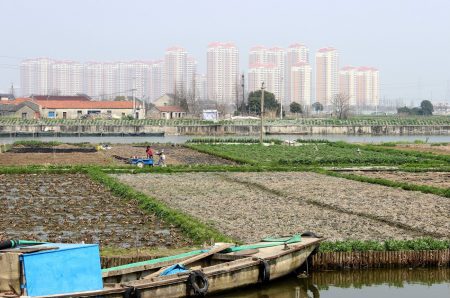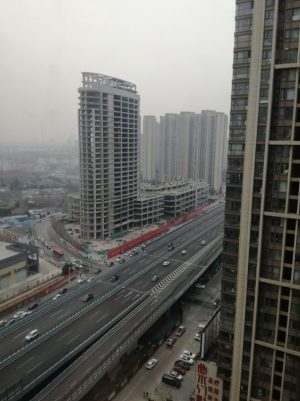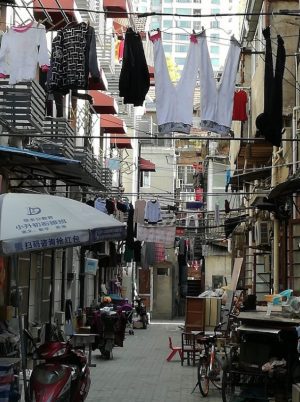China’s urban dilemmas
by Austin Williams
In 1976, the year that Chairman Mao died, China was just 17 percent urban. Today that figure is fast approaching 68 percent with new cities, large towns, metropolitan development, and urban expansion seemingly everywhere.
The banks of Pudong to the east of Shanghai’s Huangpu River for example, were until the 1990s, occupied by polluting smokestack factories and small agricultural holdings. Now this vast area is home to multinational corporate headquarters housed in some of the tallest buildings in the world. It has become a leading free trade area, with international technology innovation centres, and new regional city hubs… as well as being the architectural backdrop to a million selfies from the other side of the river.
China has expanded rapidly. At the end of the 1970s there were 198 cities in the entire country and today there are 707; 17 of which are mega-cities (containing more than 20 million people), and the intention is that there will be 900 sizeable cities by 2025. These new cities are not necessarily built from scratch, but they are no less impressive for being extensions, or huge additions, to existing smaller urban areas.
 The city of Suzhou in Jiangsu Province, for example, 75 miles to the east of Shanghai grew from a historic city of 500.000 people in 1980 to a modern city of 8.6million today. That is equivalent to Bristol’s population expanding 16 times and sprawling outwards to become the size of London… in a generation.
The city of Suzhou in Jiangsu Province, for example, 75 miles to the east of Shanghai grew from a historic city of 500.000 people in 1980 to a modern city of 8.6million today. That is equivalent to Bristol’s population expanding 16 times and sprawling outwards to become the size of London… in a generation.
Similarly, Shenzhen in Guangdong Province on the southern coast, was merely a collection of fishing villages housing 30,000 people in 1980 and it is now a mega-city of 18.5 million. That’s like Letchworth Garden City becoming Mumbai.
In that timescale, China has metamorphosed from a rural economy of peasant subsistence farming to the second largest economy in the world. Its GDP is now two-thirds the size of America and equal to that of Germany, Japan, India and the UK combined. And China’s cities, predominantly those on the eastern seaboard are now rivals to many other global cities. For example, in 2022, London was voted the fourth most expensive city in the world for ex-pats to live in, but Shanghai was eighth; at a time when the average wages in London were ten times higher than in China.
However, comparing and contrasting urban standards of living ignores the disparities between urban and rural living standards in China, which still has a lot of work still to do. A huge number of people live in poor conditions although since 2011, there has been a concerted effort to upgrade regional infrastructure. For instance: 1.2 million km of road have been built to improve connectivity of the remotest regions of China; 35,000km of railway track has been added to the network, and 108,000 schools have been upgraded.[1] For comparison, the UK build 1000km of new roads, it has lost 350km of railway track since in 2000, and its school network is famously collapsing for want of investment.
 After the shocks of the construction market in China – with the collapse of the Evergrande development company with debts of US$300 billion – the construction market is more unsettled, purchases are much more risk-averse, and prices have dropped considerably, but China is still a growing market; as it has been for 40 years.
After the shocks of the construction market in China – with the collapse of the Evergrande development company with debts of US$300 billion – the construction market is more unsettled, purchases are much more risk-averse, and prices have dropped considerably, but China is still a growing market; as it has been for 40 years.
However, while the quantity is impressive, quality has long been recognized as an essential missing ingredient in many of China’s cities. This is because they were built at speed, in the same way that most postwar reconstruction in Europe tended to focus on immediate functional need rather than aesthetic considerations. China had the urgency to grow and develop to become a rival to the West and this was achieved by a focus on “engineering” and experience in macroeconomic planning[2] rather than the niceties of architecture and aesthetics.
It was no coincidence that, until the presidency of Xi Jinping, most Politburo members of the Communist Party of China were engineers (or represented a “full-fledged technocratic leadership” as one research paper put it[3]) and architecture, design, – or “value added” – wasn’t a major consideration. The central and single-minded purpose of the country’s leaders was to build a new China as quickly and efficiently as possible. This was seen to be an engineering task in the same way that engineers were deemed to be the profession that built the British Victorian infrastructure, while architects only emerged as a meaningful profession well after the turn of the 20th century.
Fortunately for the British, Victorian engineers had an instinct to create marvels of innovation and creativity. From railway arches to the Great Exhibition, and even the sewage pumping stations along the Thames, all are impressive design interventions that captured the pride of the nation at a time when Britain ruled the world. Engineering represented British progress. China’s engineering on the other hand – remarkable though it is for its speed and extent – conveyed little more than pragmatic aspiration to progress from a relatively low starting point. Some people have noted that China’s huge urban transit networks (Shanghai’s metro system is 826km long) is actually a symptom of its inefficient planning rather than the result of sensible forethought.
It was only at the turn of the millennium that concern for the built environment became a key focus in China’s urban reconstruction. This was the moment when China could claim to be an equal in world affairs. This is when private architects, many returning from sojourns in American universities, were allowed to develop independent studios and experiment with Chinese and Western architectural styles. After a wary start, many excellent Chinese architects have begun to influence the landscape with innovative buildings matching their grand commissions, but these tend to be isolated and non-contextualised icons inserted into the urban grid. Masterplans are thought out 20 years in advance. Very often by politicians.
Take the example of urban planning which only became an independent school of study post-1989 when the old Soviet-style planning guidelines were thrown out. But even then, as one researcher puts it, the primary “goal of urbanization policies has been to regulate the economy more easily” rather than to create great places to live, work and play. As a result, Chinese parks are largely absent from many cities, seating absent from plazas, care and attention absent from many streets. Speaking of the city of Wuhan, Jan Gehl wrote that there exists an “undignified pedestrian experience.” If old ladies didn’t dance in leftover parts of the city, many urban areas would be purely drab, functional spaces.
 For 40 years, China has been urbanizing in order to accommodate its growing population often with scant regard to the finer points of urban design. The Soviet housing model of relentless block grids served its purpose in providing reasonably decent, much-improved conditions for a vast amount of poor people. The post-1998 generation of housing improved greatly on that prior model, but now China is insisting on introducing some meaningful urban quality.
For 40 years, China has been urbanizing in order to accommodate its growing population often with scant regard to the finer points of urban design. The Soviet housing model of relentless block grids served its purpose in providing reasonably decent, much-improved conditions for a vast amount of poor people. The post-1998 generation of housing improved greatly on that prior model, but now China is insisting on introducing some meaningful urban quality.
President Xi Jinping originally inveighed against “weird architecture” back in 2014 and has recently spoken of the need to shift to “high-quality growth” from “unbalanced” growth of the previous historical period. This all smacks of a social stability policy agenda but may also pose an interesting and new challenge to the design community.
The impact of the lockdown and the collapse of construction companies has narrowed the market, and state-owned Design Institutes are growing in importance over less economically stable private practices. But there is clearly a desire to help restore confidence through improving living conditions, urban environments and rural reconstruction. There is also a need to pander to the high expectations of US and European nationals who demand – in return for foreign direct investment – clean air, green corridors, fast VPN, and European-style wine bars and coffeeshops. There is now a generation of architects that have seen the potential to make their cities more sociable and inviting. Admittedly, there is still considerable pragmatic politicking being prioritised over the real needs of ordinary people, but the aspiration for social improvements and more engaging urban streetscapes is surely an ambition that cannot be put back in its box.
Austin Williams is director of the Future Cities Project, and series editor of Five Critical Essays.
[1] China’s Progress Report on Implementation of the 2030 Agenda for Sustainable Development (2023) Center for International Knowledge on Development September 2023
[2] Yu Jie, China’s New Scientists, Chatham House, 24 July 2023
[3] Cheng, Li, and Lynn White. “The Fifteenth Central Committee of the Chinese Communist Party: Full-Fledged Technocratic Leadership with Partial Control by Jiang Zemin.” Asian Survey, vol. 38, no. 3, 1998, pp. 231–64. JSTOR
.






